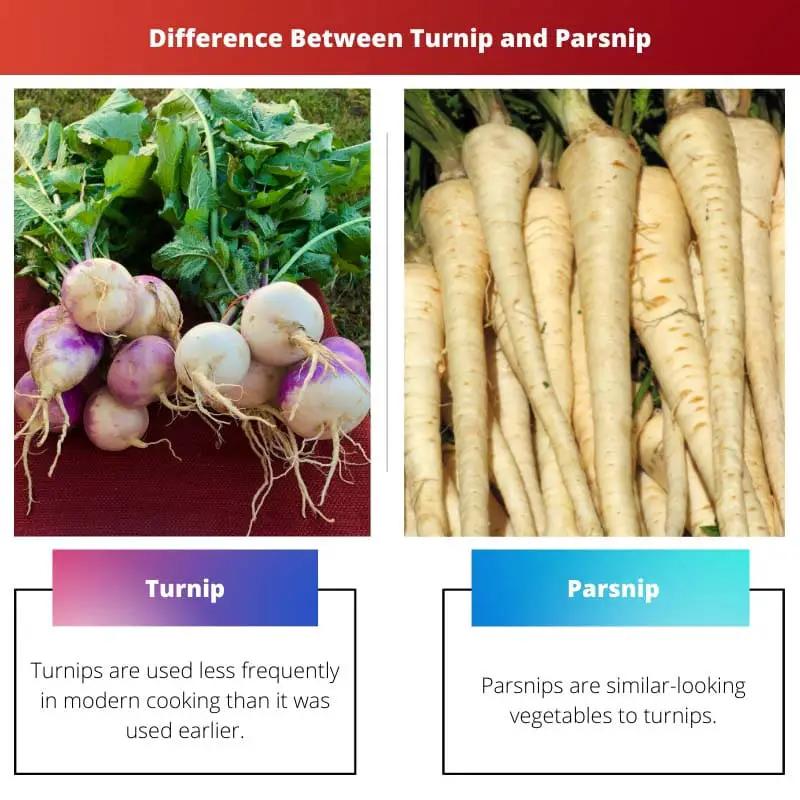Few vegetables are not used frequently, and due to that, not many are aware of them, especially the white root vegetables. Turnip and Parsnip are both white root vegetables and not many people know their differences or more information about them.
The reason could be that it is not used for cooking more commonly; in Indian cooking also, not many people prefer eating these.
Key Takeaways
- Turnips are white or purple, while parsnips are cream-colored.
- Turnips have a sharper flavor and are firmer than parsnips.
- Turnips are used in stews and soups, while parsnips are roasted or used in purees.
Turnip vs Parsnip
Turnips are round, bulbous vegetables with a white or purple top and a white bottom, having a slightly bitter taste and a firm texture when cooked. Parsnips are long and thin with a beige color and a sweet, nutty flavor, having a tender texture when cooked, and are a good source of vitamins C and K.

Turnip is a vegetable of white and purple/violet in appearance. It tastes bitter and sweet and can be grown in temperate climates.
They are beneficial for reducing cancer risks, for a heart patient, for lowering down the blood pressure level, etc., its leaves can be allergic to touch sometimes. They can be eaten as raw as a salad with some spices.
Parsnip is a white cream vegetable, also called a cousin of turnip. It is sweet and can be eaten without cooking. They can be added to salads, soups, and pickles.
It was used mostly during the earlier period for making jams, medicine for toothache, etc. They are very versatile as they can be added to more than one type of dish.
Comparison Table
| Parameters of Comparison | Turnip | Parsnip |
|---|---|---|
| Flavour | Spicer | Sweeter |
| Calories | Fewer calories | More calories |
| Carbohydrates | Fewer carbohydrates | High in carbohydrates |
| Protein | Less in protein | High in protein |
| Glycemic Index | High Glycemic Index | Lower Glycemic Index |
What is Turnip?
Turnips are used less frequently in modern cooking than it was used earlier. This is due to its less versatile nature or because not many prefer its taste.
But earlier, they used to be an important part of cooking and were harvested in large quantities.
Consuming turnips have the following benefits:
- Relieving intestinal problems: it is rich in fibers that result in lowering any intestinal problems.
- Lowering blood pressure level: it has potassium that is a very powerful nutrient for lowering the blood pressure level by releasing sodium from the body.
- Reducing cancer risk: turnip is a cruciferous vegetable that has a high level of sulforaphane in it which is useful in reducing the risk of having cancer.
- Weight loss and digestion: as mentioned above, it is rich in fiber, which helps reduce any indigestion-related problems. Also, it is low in calories, and after eating it, a person does not feel hungry for a longer duration, which results in not gaining excess weight due to high calories and overeating.
Facts about turnip:
- They are not related to potatoes.
- Turnip roots and leaves can both be used in cooking.
- Most of them are bitter.
- They are sometimes grown for feeding livestock.
- People use turnip as a pickle too.
- They are considered food for poor and humble vegetables.

What is Parsnip?
Parsnips are similar-looking vegetables to turnips. Cultivation of this has decreased so much due to less usage in cooking nowadays.
Not many people know that it is rich in many nutrients and can be beneficial for reducing several health problems.
The benefits of consuming Parsnip include:
- Supports Immune System: it is rich in vitamins that are helpful in more production of white cells so that the body can easily fight off the bacteria that might entire our body and ultimately support the Immune System.
- Improves Digestion: due to the presence of fibers in high quantity, the food inside the body gets digested easily, and it also avoids problems such as constipation, etc.
- Supports Cardiovascular System: it is rich in proteins, potassium, and minerals that altogether contribute to the well functioning of our heart, balance the blood pressure level, and avoid any kidney-related diseases. Therefore supports the entire cardiovascular system.
Facts about Parsnip:
- Earlier, parsnip was also used in place of sugar for making Jams and cakes.
- It was used in making wine and beer due to its easy fermentation property.
- Its stem can reach 60 inches in height.
- After consumption of parsnip, walnuts, parsley, and figs should be avoided as they can lead to allergies.
- It was also used as a treatment for toothache.
- It was believed that it contains aphrodisiac properties.
- It completes its lifecycle in a short span of 2 years.

Main Differences Between Turnip and Parsnip
- When compared in terms of nutrition, turnip is far behind the Parsnip, which is rich in several nutrients, such as iron, calcium, magnesium, zinc, copper, etc., along with vitamins and folate. Turnip has fewer nutrients and vitamins in comparison.
- Parsnip contains more than twice the calories of a turnip. Therefore it could be a good option for someone who wants to gain weight.
- Parsnip also has more than twice the carbohydrates of a turnip. It has 18% of the essential carbohydrates that we need for proper functioning. While turnip only contains 6 % of carbohydrates, and this is due to the low sugar in it.
- Parsnip also had higher protein content as compared to turnip. Therefore it contains all the benefits of protein-rich food.
- Turnip has a higher Glycemic Index than Parsnip.
- Both of them have separate benefits. For example, for low calorie and low-fat diet, turnip is a more suitable option, while for a low glycemic Index, Parsnip is an ideal choice.
- Also, parsnip may be allergic to some people due to the presence of psoralen that can cause the problem of photodermatitis and also some oral allergies while turnip does not contain this substance.

- https://aocs.onlinelibrary.wiley.com/doi/abs/10.1007/BF02532563
- https://dl.acm.org/doi/abs/10.1145/300515.300516
- https://onlinelibrary.wiley.com/doi/abs/10.1111/j.1558-5646.1986.tb05746.x
- https://onlinelibrary.wiley.com/doi/abs/10.1111/j.0014-3820.2003.tb00292.x
- https://pubs.acs.org/doi/abs/10.1021/jf048041s

The insights into the historical uses and medicinal properties of parsnips are truly fascinating. This adds an intriguing layer to the discussion about these vegetables.
I completely agree, Obutler. Exploring the historical significance of parsnips enhances our understanding of their cultural and culinary value.
Absolutely, Obutler. It’s captivating to learn about the diverse roles parsnips played in ancient culinary practices.
Thank you for the detailed comparison between turnips and parsnips. It’s interesting to know that turnips are mostly used in stews and soups while parsnips are used in roasting or purees.
I completely agree, Price. This information is definitely enriching our knowledge about these white root vegetables.
The health benefits of both turnips and parsnips are fascinating. I had no idea they could be so beneficial in reducing various health problems.
Absolutely, Tracy. It’s essential to understand how our food choices can positively impact our overall health.
I share the same sentiment, Tracy. This article provides valuable insights into the nutritional advantages of these vegetables.
The information presented about the historical usage and cultural significance of turnips and parsnips is intriguing. It adds a new dimension to the discussion.
I completely agree, Anthony. Understanding the culinary traditions associated with these vegetables helps us appreciate their cultural importance.
The comparison between turnips and parsnips is quite fascinating, shedding light on their unique characteristics and properties. It’s an informative read for anyone interested in expanding their knowledge of culinary ingredients.
I share the same sentiment, Alison. This comparison provides a valuable perspective on the distinctive attributes of these white root vegetables.
Absolutely, Alison. It’s essential to recognize the diverse qualities of these vegetables to make informed choices in culinary practices.
The detailed descriptions of the benefits and culinary uses of both turnips and parsnips are quite enlightening. It’s valuable information for anyone looking to diversify their dietary choices.
Absolutely, Qhunt. It’s essential to be aware of the various ways in which these vegetables can contribute to a balanced diet.
I couldn’t agree more, Qhunt. This article broadens our understanding of the culinary and nutritional aspects of these vegetables.
The details provided about turnips and parsnips are quite enriching. This article offers valuable insights into the nutritional, historical, and culinary aspects of these vegetables.
I completely agree, Fiona. This comprehensive overview enhances our understanding of the significance of these vegetables in various contexts.
The facts provided about turnips and parsnips shed light on their diverse uses and cultural significance. It’s fascinating to learn about their historical importance.
Absolutely, Helen. It’s enriching to explore the varied roles of these vegetables throughout history.
I share the same sentiment, Helen. This knowledge deepens our appreciation for these white root vegetables.
The comparison table highlights important factors such as the flavor, calories, carbohydrates, protein, and glycemic index differences between turnips and parsnips. It’s very informative.
I couldn’t agree more, King. This comparison allows us to make more informed decisions when choosing between the two.
The benefits of consuming both turnips and parsnips are indeed noteworthy. It’s intriguing to understand the positive impact these vegetables can have on our health.
I share the same view, Hughes. This article broadens our awareness of how incorporating these vegetables can contribute to a healthier lifestyle.
Absolutely, Hughes. It’s crucial to recognize the nutritional advantages of these vegetables to make informed dietary choices.